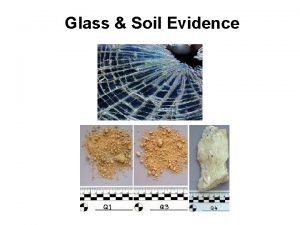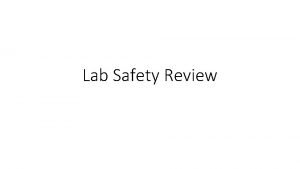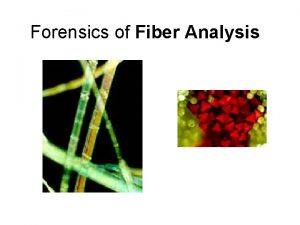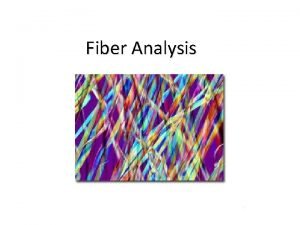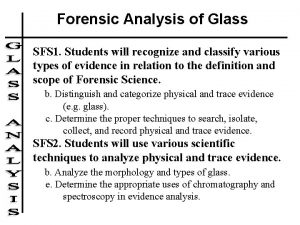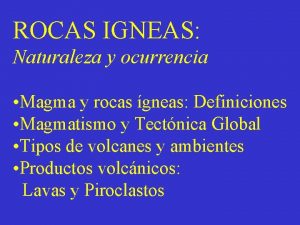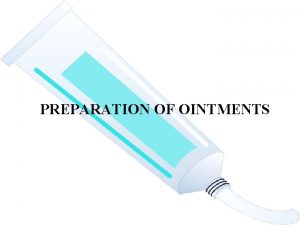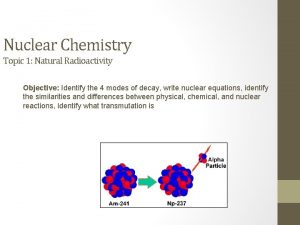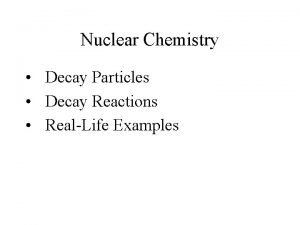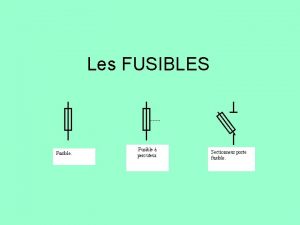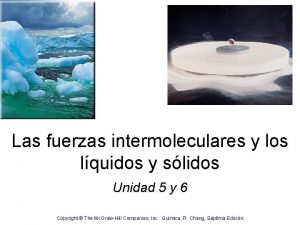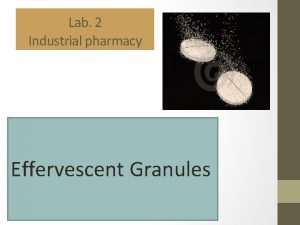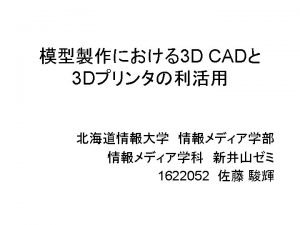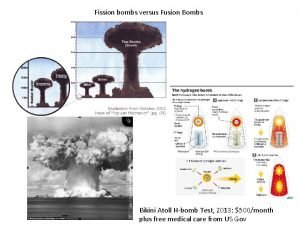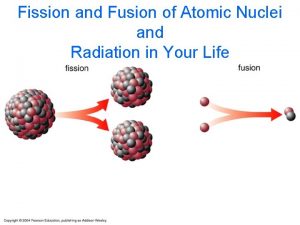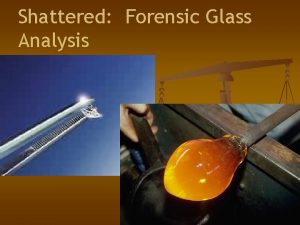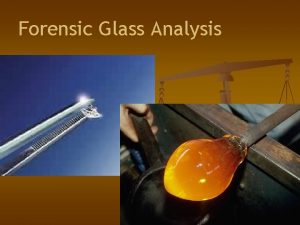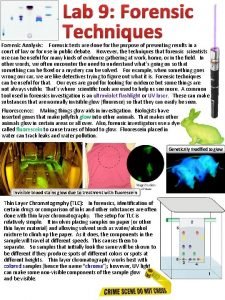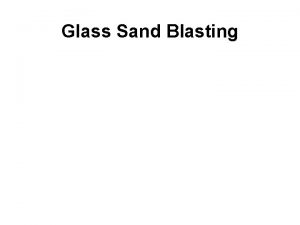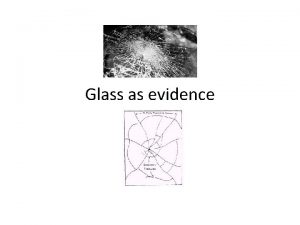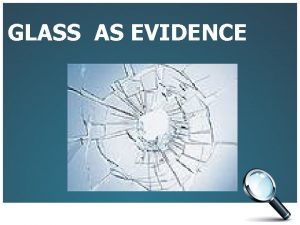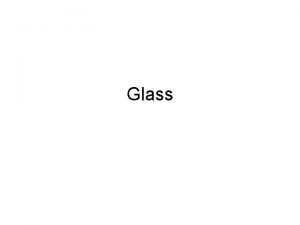Forensic Analysis of Glass What is Glass Fusion



























































- Slides: 59

Forensic Analysis of Glass

What is Glass? • Fusion of sand (Si. O 2), soda (Na 2 CO 3) & lime (Ca. O) that produces a transparent solid when cooled. • A 3 D network of atoms which lacks the repeated, orderly arrangement typical of crystalline materials. • Physical properties: hard, elastic, brittle, nonconductor of electricity, density, refractive index, etc. • Chemical: resistant to all but fluorine and very strong bases.

Characteristics of Glass Hard, amorphous solid Usually transparent Primarily composed of silica, with various amounts of elemental oxides Brittle Exhibits conchoidal fracture

Different glasses-domestic windows, car headlamps, light bulb glass-are produced differently from different chemistries.

Forensic Examination of Glass • Goals in examining glass evidence: – Determine the types of glass at the scene – Determine how the glass was fractured – Use physical characteristics to classify it – Individualize the glass to a source • Compare physical and chemical characteristics: – Optical properties: color and refractive index – Non-optical properties: surface wear, striations from manufacturing, thickness, surface film or dirt, hardness, density – Chemical properties: additives or trace elements

Trace > Glass How is glass collected? For trace evidence, usually visually collected with forceps and packaged in plastic bags.

Collection of Glass Samples • The glass fragments should be packaged in boxes to avoid further breakage. • If evidence is to be examined for glass fragments, it should be taken whole and each item individually wrapped in paper and boxed. • If even the remotest possibility exists that glass fragments may be pieced together, every effort must be made to collect all glass fragments. • Submit glass evidence along with a representative sample of each type of glass from the crime scene.

What Types of Glass Are There? The primary uses for glass are in windows, containers, light bulbs and eyewear. • Borosilicate Glass (pyrex): 5% borax (Na 2 B 4 O 7) is added to resist breaking when heated or cooled. • Colored Glass: metal oxides or colloidal iron (Fe) & sulfur (S) are added to change its color. • Lead glass: Pb increases refractive index & density

Physical Characteristics Density—mass divided by volume Refractive index (RI)—the measure of light bending due to a change in velocity when traveling from one medium to another Fractures Color Thickness Fluorescence Markings—striations, dimples, etc.

Determining Common Source • The criminalist can obtain other information on the glass characteristics – Color – Thickness – Shape – Texture

What Types of Glass Are There? • Flat glass: made by a “float glass process”; molten glass is floated on a pool of tin while cooling. Commonly found in doors and windows. • Laminated glass: used in windshields, two sheets of glass with plastic between them. • Tempered safety glass: used in car side windows and designed to break into tiny pieces; potassium (K) replaces sodium (Na) on the surface.

– Coated: Surface modification • Mirrors – Laminated: Sandwiched around plastic • Automotive windshields – Headlights: often borosilicate – Light bulbs: soda lime glass – Heat absorbing/ UV filtering • tinting – Eyeglasses: prescription lenses/photosensitive

Windshield Glass Laminated glass • Two sheets of ordinary glass bonded together with a plastic film between sheets

Major Types and Uses • Soda lime silicate glass Si. O 2 + Na 2 O / K 2 O + Ca. O / Al 2 O 3 / Mg. O – Flat glass, container glass, electric light bulbs • Borosilicate glass (aka. “Pyrex”) > 5% B 2 O 3 (replaces Na 2 O) Lab glassware, thermometers, cookware, sealedbeam headlights

Common Types Soda-lime—used in plate and window glass, glass containers, and electric lightbulbs Soda-lead—fine tableware and art objects Borosilicate—heat-resistant, like Pyrex Silica—used in chemical ware Tempered—used in side windows of cars Laminated—used in the windshield of most cars

How Float Glass is Made

Examples of Float Glass Crystal Palace railway station, London Old window in Jena, Germany Float glass = in upper left of window Thesection remaining sections are possibly not float glass as indicated by the distorted reflections

Tempered Glass: Car Front Windshields

Optical Properties of Glass Make side-by-side comparisons using similarsized fragments. Place samples on a white surface using natural light. Use both fluorescent and incandescent light to determine the glass’s color. Visual color analysis is very subjective. Dyes and pigments can be almost impossible to extract.

Nonoptical Physical Properties of Glass • Surface striations and markings – Rollers leave parallel ream marks on sheet glass – Markings may indicate the glass’s orientation when pieces are missing – Surface scratches, etchings, and other markings may also be used to individualize evidence • Other Properties – Hardness=5 -6 on Mohs scale; use a scratch test. – Determinations of curvature can distinguish flat glass from container, decorative, or ophthalmic.

Glass Transfer Evidence • When glass objects are broken, glass flies backward from all parts of the object where cracks appear not just from point of impact. • This creates a shower of minute glass particles and a transfer of evidence. • Glass fragment comparison depends finding and measuring properties that will associate one glass fragment with another while eliminating other sources.

Primary fracture= radial (lines extend outward) Secondary fracture= concentric (circular- around the point of impact)

How Do Glass Windows Break? • Each force causes a deformation that may leave a visible mark or fracture the glass. This can be used to determine the direction and amount of force. • Glass acts initially as an elastic surface and bends away when a force is applied. When the force increases beyond its tensile strength, it cracks.

Direction of Force • Direction of force can be determined by looking at the cross section of the fractures • The lines created in the glass, called ridges or Wallner lines, show distinctive patterns depending on whether the fractures from which they are collected are concentric or radial

Direction of Force • Most reliable determinations are from results closest to the original impact • Perpendicular marks are found on the edge opposite way force was pushing • Remember: – Radial cracks form Right angles on the R Reverse side of the force

Tempered Glass: Shattering Examples A telephone booth with smashed tempered glass in Holloway, London.

Trace > Glass For reconstruction: Radial cracks Concentric cracks

How Does Glass Break? • Radial cracks form first and are propagated in short segments on the side opposite the force. • Concentric cracks come later from continued pressure on the same side as the force applied.

concentric radial

How Does Glass Break? • Edges of broken pieces of glass will show rib (“stress”) marks. • In a radial crack, the rib marks are perpendicular to unloaded side and parallel to loaded side. The arrow shows the side that received the impact. • 3 R rule: – Radial cracks give rib marks that make – Right angles on the – Reverse side from where the force was applied


Exceptions to the Three R Rule Tempered glass “dices” without forming ridges Very small windows held tightly in frame can’t bend or bulge appreciably Windows broken by heat or explosion no “point of impact” curved, smooth edges at break points

Types of Fractures by Projectiles • Bullets are a projectile force (load) that can pass through glass. – Load side is the entrance side; unloaded side is the exit side. – Low-speed projectiles: rib marks may indicate where breaking force was applied – As the bullet’s velocity increases, the central hole becomes smaller, cracking patterns become simpler, and the exit hole becomes wider than the entrance hole.

Which Bullet Hole Was First? • The sequence of impacts can be determined since crack propagation is stopped by earlier cracks. In the figure above, which impact occurred first?

Putting it Back Together Again? • Examiners can fit together two or more pieces of glass that were broken from the same object. • Because glass is amorphous, no two glass objects will break the same way.

In the figure below & left, which impact occurred first? In the figure above & right, from which side did the impact occur?

Forensic Examination of Glass • Goals in examining glass evidence: – Determine the types of glass at the scene – Determine how the glass was fractured – Use physical characteristics to classify it – Individualize the glass to a source • Compare physical and chemical characteristics: – Optical properties: color and refractive index – Non-optical properties: surface wear, striations from manufacturing, thickness, surface film or dirt, hardness, density – Chemical properties: additives or trace elements

Forensic Analysis of Glass

Quantitative Properties of Glass

Density • Density is mass / volume • Determined by using a floatation technique in which the composition of liquid is varied until the glass sample remain suspended in it

Glass Density • Density can be measured by: • directly determining mass and volume (usually by displacement) • comparison by flotation • comparison using a density gradient column • Density gradient column method: • Fragments of different densities settle at different levels in the column of liquid of varying density. • Technique is not accurate for fragments that are cracked or contain an inclusion.

Density by the Flotation Method • A glass particle is immersed in a liquid. The density of the liquid is adjusted by the addition of small amounts of another liquid until the glass chip remains suspended. • At this point, the glass will have the same density as the liquid medium and can be compared to other relevant pieces of glass which will remain suspended, sink, or float.

Why Measure Density? • Can be used as a screening technique with large numbers of fragments. • Useful in identifying multiple sources present in the known and/or questioned samples. • It is nondestructive and an intensive property (not dependant on sample mass). • Need to measure very precisely in parts per hundred or thousand or better.

Density Type of Glass Density window 2. 46– 2. 49 headlight 2. 47– 2. 63 Pyrex 2. 23– 2. 36 lead glass 2. 9– 5. 9 porcelain 2. 3– 2. 5

Why Measure Refractive Index? • Refractive index: ratio of the velocity of light in a vacuum to the velocity of light in any other medium • For example, at 25 o. C the refractive index of water is 1. 333. This means that light travels 1. 333 times faster in a vacuum than it does in water. • Like density, refractive index is an intensive property but it can be measured very precisely (± 0. 0002) and does not destroy the sample. • Refractive index of glass varies with small changes in composition or by how it is manufactured.

Snell’s Law N=1. 52 N=1. 33 The higher the n, the more the light bends

Refractive Index By Immersion

Refractive Index By Immersion • Immersing a glass particle in a liquid medium (silicone oil) whose refractive index can varied with temperature until it is equal to that of the glass particle. • At this point, known as the match point, the Becke line disappears and minimum contrast between liquid and particle is observed: RI oil = RI glass. • The Becke line is a bright halo near the boarder of a particle that is immersed in a liquid of a different refractive index.

When 2 substances have different RI, light passing through them produces a Becke Line A Becke line is a band or rim of light visible along a grain/crystal boundary in plane-polarized light.

Becke Lines Glass has higher refractive index-note white line inside • Glass has lower refractive index-note white line outside

Problems with Refractive Index The measurement of RI alone can be of limited use because RI distributions of flat glasses and container glasses overlap. Histogram = flat glasses Curve = container glasses

Problems with Refractive Index 1964 -1979 1980 -1997 A rough statistical estimate of the likelihood of finding glass of that refractive before 1970 Manufacturing changed in late 1970’s making glass more uniform

FBI Refractive Index vs Density Data • The FBI has compiled density and refractive index data for glass from around the world. • The FBI has identified a relationship between their refractive indices and densities for 1400 glass specimens that is better at classification.

Chemical Analysis of Glass • Fluorescence – Under UV radiation, many glasses exhibit fluorescence (glow) – Caused by heavy metals (including tin) from “float” process or organic coatings • Scanning Electron Microscopy Energy Dispersive X -ray Analysis – Can determine many elements simultaneously – Surfaces of samples (>50 mg) can be analyzed • Atomic Absorption Spectroscopy – You must first know which elements are present – Can analyze ppm levels of elements present

1. Which unique chemical component would be found in each type of glass shown below? (beaker) (windshield) (crystal) Can lead borosilicate glass can be distinguished from borosilicate glass by density, refractive index, or both.

Quantitative Properties of Glass

Flame test of glass It might be possible to detect metals in large quantities found in a glass sample by a microflame test. Sodium vs potassium, Li etc.

The Wave of the Future: Laser Ablation • Laser Ablation Inductively Coupled Plasma Mass Spectrometry (LA-ICP-MS) – Laser burns off a microscopic sample – Elements are ionized by plasma – Detects 46 trace elements and their isotopes simultaneously in glass at < 1 ppb

http: //www. videojug. com/interview/csi-of-glass-and-light-2
 Flotation method glass
Flotation method glass Radial fractures in glass
Radial fractures in glass Forensic anthropologist vs forensic pathologist
Forensic anthropologist vs forensic pathologist Who is this
Who is this Glass evidence in forensic science
Glass evidence in forensic science Glass ceiling glass escalator
Glass ceiling glass escalator True or false hot glass looks the same as cold glass.
True or false hot glass looks the same as cold glass. Does hot glass look like cold glass
Does hot glass look like cold glass Handwriting analysis forgery and counterfeiting worksheet
Handwriting analysis forgery and counterfeiting worksheet Fibers forensics
Fibers forensics Tire track evidence
Tire track evidence Fibers from animals
Fibers from animals Forensic analysis of paper
Forensic analysis of paper Forensic analysis of hair
Forensic analysis of hair Owasp cloud incidence analysis and forensic
Owasp cloud incidence analysis and forensic Passive bloodstains
Passive bloodstains The lady in the looking glass questions and answers
The lady in the looking glass questions and answers Glass house & philip johnson analysis
Glass house & philip johnson analysis Chip of glass meaning
Chip of glass meaning Glass roses analysis
Glass roses analysis Pyrex glass forensics
Pyrex glass forensics Donald barthelme the glass mountain
Donald barthelme the glass mountain Artificial transmutation worksheet
Artificial transmutation worksheet Nnemp
Nnemp Ift nc
Ift nc Think central science fusion
Think central science fusion Propiedades de xenon
Propiedades de xenon Operator fusion deep learning
Operator fusion deep learning What is the formula for latent heat
What is the formula for latent heat Protoplast fusion
Protoplast fusion Smart fusion pole
Smart fusion pole Smart fusion pole
Smart fusion pole Fission vs fusion
Fission vs fusion Fusion por descompresion
Fusion por descompresion Pyroelectric fusion ppt
Pyroelectric fusion ppt Ointment preparation by fusion method
Ointment preparation by fusion method Orchid tissue culture media
Orchid tissue culture media Cache fusion
Cache fusion Are nuclear power plants fission or fusion
Are nuclear power plants fission or fusion Nuclear fission and fusion similarities
Nuclear fission and fusion similarities Nucluar energy
Nucluar energy Nuclear chemistry
Nuclear chemistry Fusible avec percuteur
Fusible avec percuteur 1 mol
1 mol Granule dosage form
Granule dosage form Fusion liberal conservadora
Fusion liberal conservadora Inertia xray
Inertia xray Google fusion tables api
Google fusion tables api Tig (tungsten inert gas)
Tig (tungsten inert gas) Fusion medical staffing llc
Fusion medical staffing llc Fusion inspector
Fusion inspector Installing fusioncompute
Installing fusioncompute Sun fission
Sun fission Scad fusion360
Scad fusion360 Fussion vs fission
Fussion vs fission Fission vs fusion
Fission vs fusion Fission vs fusion nuclear
Fission vs fusion nuclear Fusion figura fondo
Fusion figura fondo Fusion chemistry phase change
Fusion chemistry phase change Direct fusion drive
Direct fusion drive




